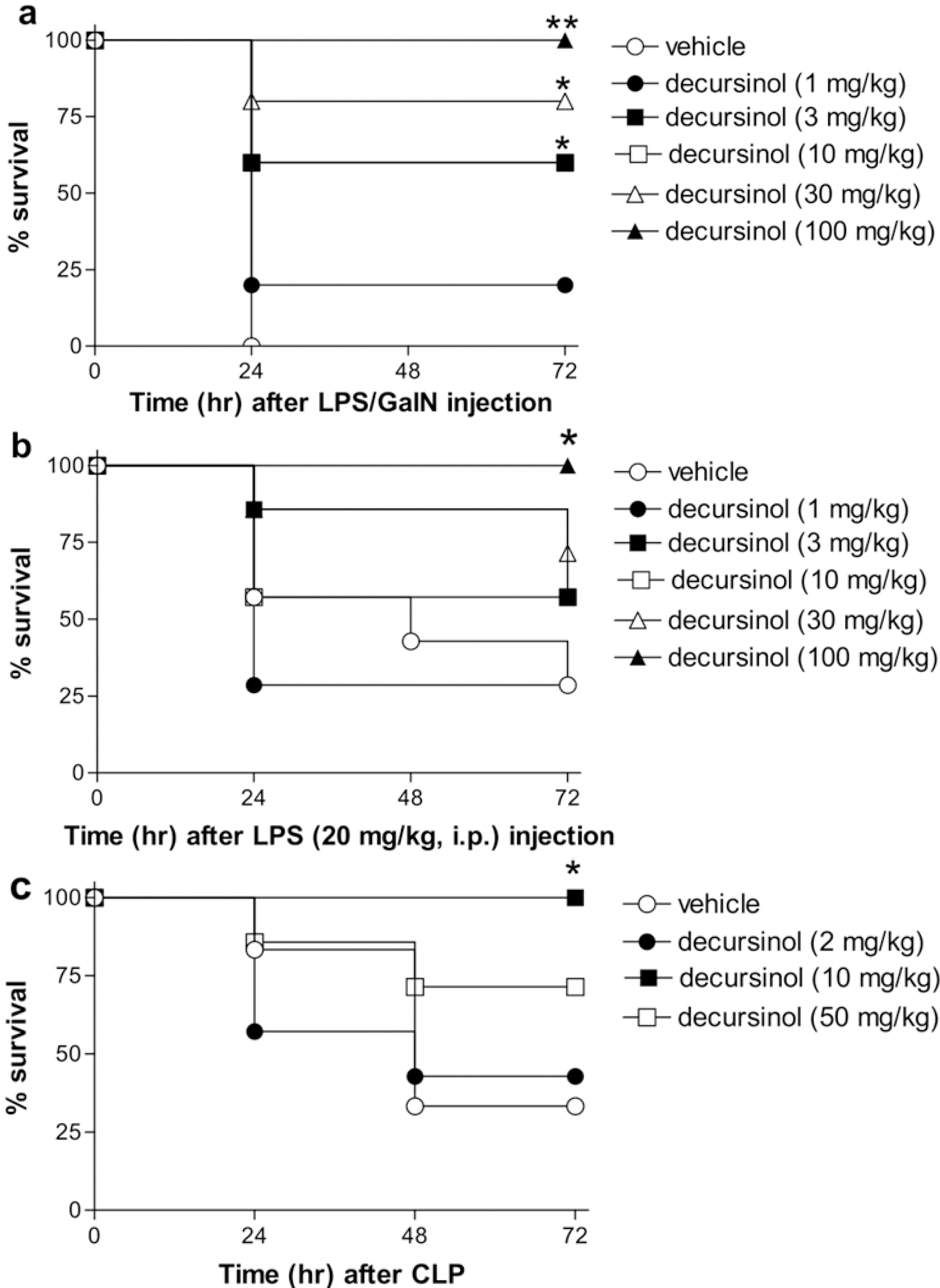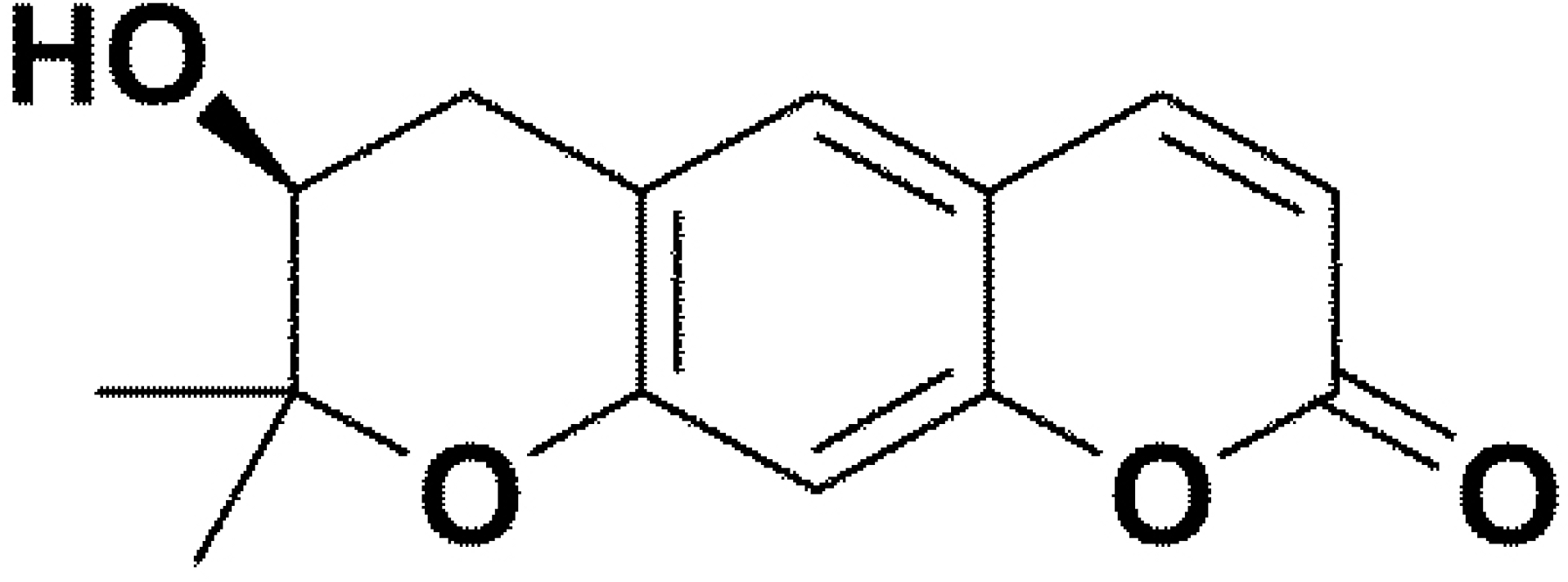Abstract
The effects of decursinol on various models of sepsis were investigated. Intra-peritoneal pretreatment of mice with various doses of decursinol (1~100 mg/kg) effectively suppressed lethality induced in three mouse models of experimental sepsis, i.e., lipopolysaccharide (LPS)/D-galactosamine (GalN), high-dose LPS (20 mg/kg), and cecal ligation and puncture (CLP). Intra-peritoneal pretreatment of mice with decursinol (50 mg/kg) markedly enhanced the LPS/GalN-induced increase of plasma interleukin-10 (IL-10) levels, without affecting plasma TNF-α, IL-6 and IL-12 levels. These results suggest that decursinol could be effective for prevention or treatment of sepsis.
REFERENCES
Choi SS., Han KJ., Lee JK., Lee HK., Han EJ., Kim DH., Suh HW. Antinociceptive mechanisms of orally administered decursinol in the mouse. Life Sci. 13:471–485. 2003.

Galanos C., Freudenberg MA., Reutter W. Galactosamine-induced sensitization to the lethal effects of endotoxin. Proc Natl Acad Sci USA. 76:5939–5943. 1979.

Howard M., Muchamuel T., Andrade S., Menon S. Interleukin-10 protects mice from lethal endotoxemia. J Exp Med. 177:1205–1208. 1993.
Lee JK., Choi SS., Lee HK., Han KJ., Han EJ., Suh HW. Effects of ginsenoside Rd and decursinol on the neurtotoxic responses induced by kainic acid in mice. Planta Med. 69:230–234. 2003.
Nemeth ZH., Hasko G., Vizi ES. Pyrrolidine dithiocarbamate augments IL-10, inhibits TNF-alpha, MIP-1alpha, IL-12, and nitric oxide production and protects from the lethal effect of endotoxin. Shock. 10:49–53. 1998.
Nguyen HB., Smith D. Sepsis in the 21st century: recent definitions and therapeutic advances. Am J Emerg Med. 25:564–571. 2007.

Pestka S., Krause CD., Sarkar D., Walter MR., Shi Y., Fisher PB. IL-10 and related cytokines and receptors. Annu Rev Immunol. 22:929–979. 2004.
Ryu KS., Yook CS. Studies on the coumarins of the root of Angelica gigas Nakai. Yakhak Hoeji. 11:22–26. 1967.
Scumpia PO., Moldawer LL. Biology of IL-10 and its regulatory roles in sepsis syndromes. Crit Care Med. 33:S468–S471. 2005.
Suberville S., Bellocq A., Fouqueray B., Philippe C., Lantz O., Perez J., Baud L. Regulation of interleukin-10 production by beta-adrenergic agonists. Eur J Immunol. 26:2601–2605. 1996.
van der Poll T., Marchant A., Buurman WA., Berman L., Keogh CV., Lazarus DD., Nguyen L., Goldman M., Moldawer LL., Lowry SF. Endogenous IL-10 protects mice from death during septic peritonitis. J Immunol. 155:5397–5401. 1995.
Yan JJ., Jung JS., Lee JE., Lee J., Huh SO., Kim HS., Jung KC., Cho JY., Nam JS., Suh HW., Kim YH., Song DK. Therapeutic effects of lysophosphatidylcholine in experimental sepsis. Nat Med. 10:161–167. 2004.

Yan JJ., Kim DH., Moon YS., Jung JS., Ahn EM., Baek NI., Song DK. Protection against beta-amyloid peptide-induced memory impairment by long-term administration of extract of Angelica gigas or decursinol in mice. Prog Neuropsychopharmacol Biol Psychiatry. 28:25–30. 2004.
Fig. 2.
Protective effect of decursinol on lethality which was induced by LPS/GalN (a), high dose LPS (b), and CLP (c). Decursinol was injected intraperitoneally (i.p.) 30 min prior to the i.p. administration of LPS/GalN (a), and high dose LPS (b). Decursinol was i.p. administered twice at 2 h and 4 h after CLP. Number of mice for each group was five (a), seven (b), and seven (c). ∗p<0.05, ∗∗ p<0.01 significantly different from vehicle-treated group.

Fig. 3.
Enhancement of LPS/GalN-induced plasma IL-10 levels by pretreatment with decursinol. Decursinol was i.p. administered 30 min prior to the i.p. administration of LPS/GalN, and plasma levels of cytokines were measured 1.5 h after i.p. administration of LPS/GalN. Data represent means±SEM of five to seven mice. ∗∗∗p<0.001 significantly different from LPS/GalN-treated group at the time point.





 PDF
PDF ePub
ePub Citation
Citation Print
Print



 XML Download
XML Download